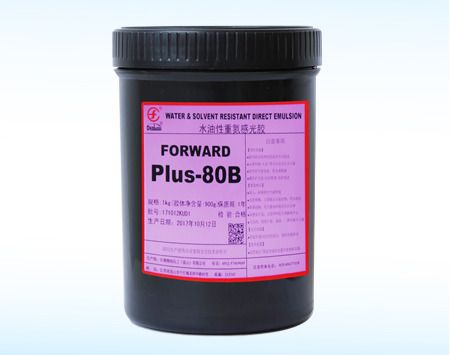Emulsion Plus-80B
Suitable for PCB, FPC, advertising signs, flower paper and other high-definition lines, dot screen printing
一、Scope of application
1.1 PLUS-80B is a diazo, solvent and water resistant photosensitive resin;
1.2 Applicable to PCB, FPC, advertising signs, flower paper and other high-precision lines, dot-screen printing;
1.3 Suitable for making screens with fine lines.
二、Traits
Exterior | specification | Colloid weight | Solid content | Viscosity(mPa.s) | Diazo |
BViscometer,25℃ |
Blue sticky lotion | 1kg/barrel | 900g | 38% | 15,000 | G2-3.0g |
5kg/barrel | 4,500g |
三、Performance characteristics
3.1 Compliance with EU RoHS Directive 2.0 (EU RoHS Directive 2011/65/EU)
Conforms to the EU 16P certification standard (EU Directive 2005/84/EC);
3.2 It has excellent solvent resistance, water resistance and moisture resistance, and has high printing durability;
3.3 high sensitivity, short exposure time;
3.4 High resolution, good graphics reproducibility, can produce fine lines of the screen;
3.5 High solid content, excellent coating performance, good leveling, smooth surface of the screen and fast development speed;
3.6 The film formation is hard, and a dimensionally stable printing effect can be obtained.
四、Reference exposure time
Screen type | Angle | Film thickness | light source | Lamp distance | Optimal exposure time |
250T(Y) | 22.5° | 15±1µm | Ultra high pressure mercury lamp3KW | 1m | 2.5minute |
It is recommended to perform double exposure after development, which can effectively improve the printing durability and improve the film peeling property.
Instructions
1. Sensitization: Dissolve diazo in about 70-100 g of purified water. Then, pour the diazo solution into the photoresist, stir it well with a glass rod or a wooden stick, and use it until the bubbles have completely disappeared.
2. Coated: coated with high quality scraper. The characteristics of the coating are related to the size of the screen and the magnitude of the tension.
The number of coating works is confirmed in accordance with the needs of the printed matter in order to obtain a desired film thickness.
If it is required to coat two projects or more, the next project must be carried out after the previous engineering coating screen is completely dried, otherwise the film will fall off.
3. Drying: It is best to control the drying temperature below 40 °C. If the temperature is too high, the thermal reaction of the photosensitive adhesive will affect the plate making effect, and the screen should be fully dried.
4. Exposure: The best light wave is 300-400nm. It is better if you use ultra-high pressure mercury lamp or high pressure iodine gallium lamp.
5. Development: It is recommended to use a high pressure water gun or a spray gun to flush the layout at a constant speed.
6. Drying: After development, remove the moisture on the surface of the screen, and then dry it in a drying oven below 40 °C. It should be fully dried, otherwise the screen will be easy to break.
7. Double exposure: Exposure to the S surface, the exposure time is 1-2 times of the P-side exposure, which can greatly improve the printing durability.
8. Hardening: After the screen is completely dry, apply the mixed A+B hardening solution evenly on the P and S sides of the screen. After 1-2 minutes, use the air gun to blow through the ink area, dry 20-30. Minutes can greatly improve the printing durability of the screen.
Precautions
1. Photosensitive adhesive preservation: The storage temperature of the photosensitive gel colloid before unsensitization is best in the cold and dark place of 20 °C. Do not store in an environment above 25 ° C or below 5 ° C, otherwise it will be susceptible to chemical and physical changes, affecting normal use. Please store the diazo in the 0-5 °C refrigerator.
2, the degreasing of the screen: the screen before the application of the photosensitive glue, should be thoroughly cleaned with a special degreaser to remove grease and dirt. After thorough cleaning and drying, high-quality screens can be obtained and the printing durability can be improved.
3. Dissolved by diazo: pure water or purified water should be used for dissolving diazo. If tap water is used directly, the minerals and rust in tap water will react with the photographic adhesive, which will affect the performance. If it is serious, the colloid will agglomerate. Normal use.
4. Drying box temperature: The temperature of the drying oven is preferably below 40 °C. When the temperature exceeds 40 °C, the photosensitive adhesive is prone to thermal reaction, which reduces the resolution. The drying box should have a venting device to allow moisture to escape from the tank and improve the complete drying efficiency of the screen. It is necessary to check whether the temperature inside the oven is consistent with the set temperature every month. It is necessary to check whether the temperature inside the oven is consistent with the set temperature every month.
5. Development in winter: If the developing water temperature is too low in winter, the development of the screen will be poor and the resolution will be degraded. It is recommended to use warm water (25 ° C) for development.






